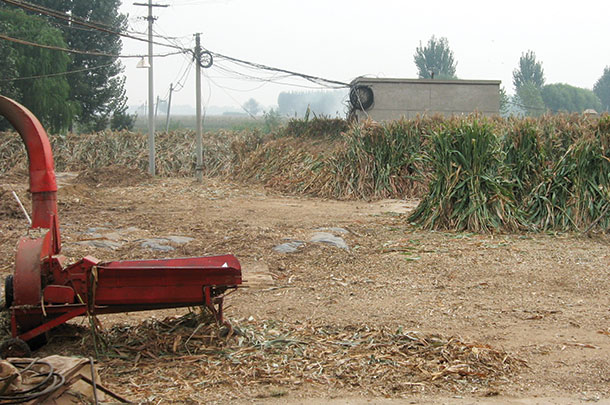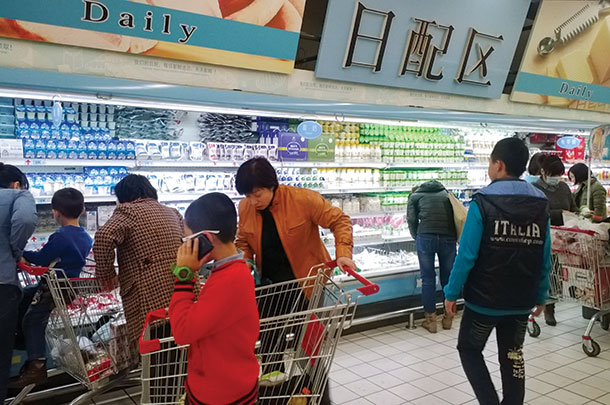Editor’s note: The full version of this article is available in a downloadable ebook format.
China has been the elephant in the dairy barn for the past 20 years. Robert Collier, professor and former chairman of the Department of Animal Sciences at the University of Arizona, describes it as an “overnight phenomenon.”
While statistics tell part of the story, what’s the view from inside the country?
Progressive Dairyman recently asked five experts to share their experience and insight. From the alfalfa-growing regions of inner Mongolia to the urban metropolis of cities like Shanghai, they have lived and worked in country while witnessing unimaginable change.
China’s importance to the worldwide dairy industry
A large and growing demand for dairy products in China cannot currently be met with domestic production. The country relies heavily on imports, and the impact is felt by U.S. dairy farmers, dairy-related businesses and academia.
With 1.3 billion people, or almost 19 percent of the world’s population, China is the most populous country in the world. And this population is growing with 16 million babies born annually – babies usually fed imported infant formula.
“Foreign companies are investing in China because they realize that the demand for milk is not going away, and it is not sustainable to keep importing,” says independent nutritionist Frank Delfino.
Dairy-related businesses have their eye on the monstrous potential for sales. “This market seems to be a great place for the major milking equipment manufacturers to roll out new technology, as well as companies with heat detection, rumination and activity tools,” Delfino says.
Academia is also seeing the benefit of the expanding dairy industry in China with their growing hunger for both knowledge and trained people. The Chinese respect U.S. expertise in addition to American milk.
History of dairy in China
The death of Chairman Mao Zedong in 1976 made private ownership of cows a possibility for the modern Chinese dairy farmer. Over the next 30 years, China began emulating many of the developed world’s habits, including their consumption of dairy products.
“In China, the perception is that if you buy milk products, you’re doing well,” explains Jeffrey Elliott of Balchem Corporation.
By 2006, China’s Premier Wen Jiabao, head of the government, said, “I have a dream, and my dream is that each Chinese person, especially the children, can afford to buy one jin (500 grams) of milk to drink every day.” His comment changed world dairy markets instantaneously.
Dairy nutritionist Walter Chen is a native of China and vividly remembers Jiabao’s comment. “I felt that government finally recognized the importance of dairy products as part of the diets,” he recalls.
Within two years, the fledgling dairy industry was rocked when more than 300,000 children experienced debilitating kidney stones and renal failure from melamine-tainted milk products. Approximately 12,000 children were hospitalized, and at least six died.
More than 20 Chinese companies were found to have added melamine, high in nitrogen, to milk products in order that they would appear to have higher protein content and thus higher value.
Chinese consumption of domestic dairy products slowed and imports, especially of infant formula, rose dramatically.
Since then, the dairy industry has gone through an entire restructuring process with greater attention devoted to safety.
“The large-scale dairies didn’t really take off until the melamine scandal,” Delfino explains. “At that point, the Chinese government made the decision to promote size and safety.
From the government’s perspective, it is much easier to control a 5,000-head operation than 500 10-cow operations.”
Ultra high-temperature (UHT) processed milk also grew in popularity as the Chinese people viewed the products safer than other forms of pasteurization and storage. As a result, the larger grocery stores of the major metropolitan cities offer Chinese consumers much more milk product variety than is available in the U.S. “Their dairy sections are huge,” Elliott describes.
Current state of China’s dairy industry
There are currently three groups of dairy farms in China – backyard cooperatives, medium farms and large, vertically integrated corporate enterprises. Elliott describes each group in greater detail.
Chinese backyard farmers who own from five to 50 cows pool their herds on community farms commonly called “cow hotels” (yangzhi xiaoqu). Generally, those dairies don’t have very high milk production. In Elliott’s words, “They’re milking the way we did 50 years ago.” The average production is generally less than 25 kilograms per cow or 55 pounds per day.

The second type of Chinese dairy today is medium farms that milk up to 500 cows. More than likely, the same person owns all the cows on a medium-sized farm.
At this point, Elliott stops to explain a key difference in addressing herd size. “When you ask how many cows a farmer has, U.S. producers answer with the number of milking cows in their herd,” he explains.
“In China, dairymen include every animal on the farm – milking cows, dry cows, growing heifers, baby calves, goats, dogs and cats. The larger their numbers, the more successful they at least appear to be.”
Chinese dairy farms that are vertically integrated usually have herds larger than 500 cows. Average production per cow is 28 to 35 kilograms or 62 to 77 pounds per day. These farms own the milk processing plant, the feed mills and the cows.
“There are a lot of similarities between large dairies in China and in the U.S. in terms of dairy facilities, milking equipment and feeding practices,” Chen says.
Some of the vertically integrated dairies may not own enough cows to supply all their milk processing needs. Therefore, these dairies may also be buying milk in order to meet demand.
These large Chinese dairies are targets for the allied industry companies. “The highest-producing dairy operation that I know of in China is averaging 36 kilograms (79 pounds), milking 36,000 head on six dairies,” Delfino says. “They have control over their crop land for silage, import quality forages from the U.S. and Australia, and have identified consistent quality suppliers of feed grains and concentrates.”
One thing common to almost all Chinese dairies today is expensive feed. “Feed cost is roughly 50 to 60 percent of milk revenue,” Chen explains.
With local production, quality forage and silage is a huge concern.
“Many of the large Chinese dairies don’t have control over enough land to guarantee their feed supplies, and there isn’t a ‘culture of quality’ in the farming community,” Delfino says. “The local farmers just want to produce tons, not necessarily tons of top-quality forages.”
Historically, Chinese labor has been relatively inexpensive, but that too is changing.
“A full-time parlor worker was paid $200 per month in 2008; today, that person is making $500 per month,” Chen explains. “A farm manager of 3,000 cows used to get paid $1,500 per month; in 2016, it’s $4,500 to $5,000 monthly.” With a farm of 5,000 cows employing 160 to 180 people, total labor cost today is high.
Like many businesses in the country, corruption is widespread throughout the Chinese dairy industry. Often, milk passing a test is more dependent on the amount of money paid rather than the science.
Elliott knows the system. “Giving money to someone to get something done is normal in China,” he explains. “In fact, it’s expected.” Once while having tea, a dairy manager told the U.S. nutritionist he would try their product for 5,000 U.S. dollars. “That money would go directly to him, not the dairy,” Elliott says.
And finally, while waste management is a concern for both U.S. and European dairies, the Chinese have found an alternative solution. “They’ve built big digesters that make methane from manure,” Willis says. “They don’t put manure back on the land.”
Future challenges for the Chinese dairy industry
The five experts agree that China faces five significant challenges as their dairy industry strains to meet the demands of their people. These challenges are feed quality, production costs, infrastructure, milk integrity and management skills.
“China’s greatest limiting factor is accessibility of high-quality forage,” Elliott says. Hay grown in China has widespread quality issues. “Local hay is often all rain-damaged,” explains Willis.
Although labor has traditionally been a cheaper expense for Chinese dairies, the future challenges include labor efficiency. Elliott says, “Everything in China is based on hand labor.”
Genetics is another production cost that challenges Chinese dairymen. “They have to improve genetics in order to increase milk production,” Willis says.
 Infrastructure is a third challenge. “I’ve seen dairies less than 5 years old that were already requiring headlock and freestall loop replacement,” Delfino says. Concrete issues and rapid deterioration occurs throughout China.
Infrastructure is a third challenge. “I’ve seen dairies less than 5 years old that were already requiring headlock and freestall loop replacement,” Delfino says. Concrete issues and rapid deterioration occurs throughout China.
The experts agree the Chinese dairy industry must continue working to address quality issues with regard to milk and milk products. The melamine scare of 2008 must still be overcome.
But perhaps the greatest challenge for the Chinese dairy industry is the management skills of their employees. “The Chinese are really, really smart,” Elliott says. “What they are lacking is experience.”
Reproduction is a specific challenge. “While they have a huge number of animals, they also have low reproductive success rates,” Collier says. “A 3,000-cow dairy may only be milking 300 animals due to repro problems.”
Larger farms are constantly looking for managers from outside of China. “Building a facility is not any guarantee of success if they can’t manage the animals,” Collier says.
The experts agree the Chinese dairy industry must continue working to address quality issues with regard to milk and milk products. The melamine scare of 2008 must still be overcome; people remain concerned.

Some of the large, vertically integrated corporate dairies are addressing this challenge head-on, such as the Chinese dairy where Willis consults. “They built a new showplace, two rotary parlors milking Jerseys and Holsteins,” he describes.
“They invite the public to come there so they can present the image of a healthy, good environment including on-site lab analysis.” The mega dairies are trying to show that they take care of the cattle and make a good, clean milk product. “You can watch the cattle ride on the carousel,” he says. “Their message is clear: You shouldn’t be afraid of the milk you drink.”
Conclusion
As the world’s most populous country, China remains the elephant in the dairy barn. Backed by their government, the dairy industry will continue experiencing growing pains as they seek to meet a created demand for milk protein.
“It will take years for China to compete,” Collier says. But Chinese native Chen banks on milk’s staying power in China.
“More and more people recognize the nutrition of dairy products, especially among the young Chinese,” he says.
During the next decade, watch how China handles feed quality, production costs, infrastructure challenges, milk integrity and management skills. Take note of their domestic production and whether their imports continue to grow. Sooner or later, the U.S. dairy industry will be unable to ignore the elephant in the dairy barn. PD
PHOTO 1: “Bulk feed” often arrives at Chinese dairies in bags. Because their economy is based on manual labor, efficiency is one of the greatest challenges facing the industry.
PHOTO 2: As recent as six years ago, Chinese dairy farmers would purchase silage from corn farms often transported by bicycle. Since no one farmer owned a lot of ground, as many as 100 different people would bring their silage to the farm as stalks, normally with the corn ears already off. Today, large farms obtain silage by truck similar to U.S. dairies.
PHOTO 3: Larger Chinese grocery stores offer consumers much more milk product variety than is available in the U.S. Note the dairy section is labeled “Daily.”
PHOTO 4: Flavored UHT milks such as banana are wildly popular in China. UHT milk grew in popularity as the Chinese people viewed the products safer than other forms of pasteurization and storage. The question remains if organic in China means the same as in the U.S. Photos courtesy of Jeffrey P. Elliott.
Beyond Print: Click here to get to know the sources used in this feature story.








